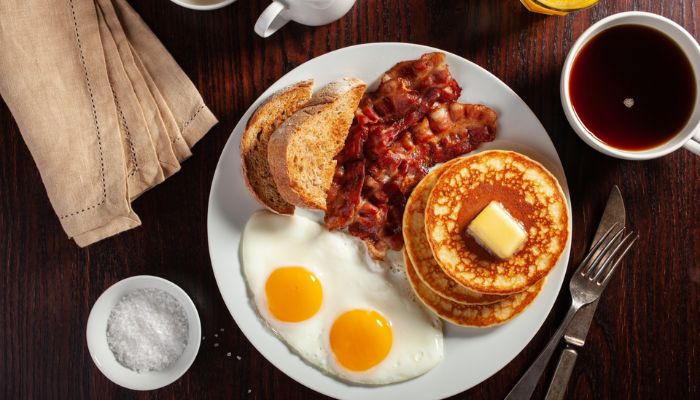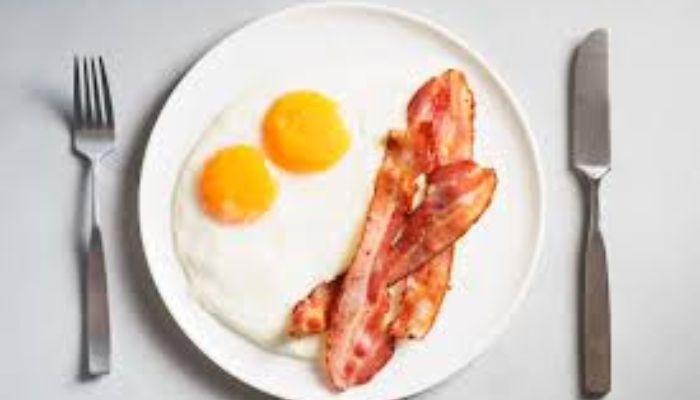People often ask me, “How many calories are in bacon?” since I’ve been a nutritionist for more than seven years. One of the most popular breakfast foods, but also one of the least understood when it comes to health. Here we will read about “Bacon Calories What’s in Your Breakfast Favorite”.
I’ll tell you how many calories and nutrients are in each type of bacon in this blog post so that you can make an informed choice. Along with that, I’ll talk about how to eat bacon as part of a healthy breakfast.
How Many Calories Does Bacon Have?
There are a lot of calories and fat in bacon compared to other protein foods. There are about 41 calories and 3.5 grams of fat in a slice of pan-fried bacon. Most of the calories come from fat.
This is how many calories are in 3 ounces, which is about 6 slices of pan-fried bacon:
- 253 calories
- 24 grams of fat
- 8 grams of saturated fat
- 71 mg of cholesterol
- 821 mg of sodium
- 15 g of protein
This shows that 6 slices of bacon have more than 250 calories and about 36% of the daily recommended amount of saturated fat. There are also large amounts of cholesterol and sodium in it.
The number of calories in bacon is a little different depending on how it is cut and cooked:
- If you fry it, each slice has 41 calories.
- 36 calories per slice when baked in the oven
- Each slice of turkey bacon has 26 calories.
That means turkey bacon has fewer calories than pork bacon. Putting it in the oven instead of frying it also cuts down on the calories.
Other Factors That Impact Bacon Nutrition
Type of Cut
The amount of fat and calories in bacon depends on what kind of pork is used to make it. It’s possible to get bacon from different parts of the pig, like the hip, back, or side cuts.
The fattiest part of the pig is used to make belly bacon, which has the most fat. Back bacon, which comes from the pork loin like Canadian bacon, has less fat than belly bacon because it comes from the loin.
Thickness
There are more calories and fat in thicker bacon slices than in thinner ones. To cut down on calories, choose the thinnest slices you can find.
How to Cook
When you fry bacon, it gets smaller but soaks up more grease, which makes it fattier and higher in calories. When you bake bacon, it doesn’t shrink as much, so you may eat less of it for the same amount of calories.
Brand and Tastes
A lot of the time, maple- and honey-flavored bacon has extra sugars added to it, which makes it denser. Compare brands and pick the ones with fewer calories by reading the nutrition label.
As a nutritionist, I tell people to choose back bacon with less fat and bake it instead of frying it to make it lower in calories. But keep in mind that all bacon, no matter how it’s cooked, is high in sodium and saturated fat.
How to Eat Bacon While Staying Healthy
Just one or two slices of bacon mixed into a breakfast will give it that smoky, salty taste. If you want to eat bacon as part of a healthy diet, here are some tips:
- To cut down on fat, choose turkey or center-cut bacon.
- To cut calories, bake or microwave instead of frying.
- Use a paper towel to soak up extra grease from fried bacon.
- Crumble bacon and put it on sandwiches, omelets, or breakfast tacos.
- Put bacon with foods that are high in fiber, like oatmeal or vegetables.
- Round out the meal with whole-grain toast instead of white toast.
- As a treat, only eat bacon once or twice a week.
As a nutritionist, I tell people who are worried about their heart health or cholesterol that they shouldn’t eat bacon every day. Instead of making up most of the protein in your breakfast, use bacon to add flavor.
Healthy Breakfast Ideas with Bacon
I like adding a few pieces of bacon to these breakfast recipes because they make them taste better:
- Whole wheat toast with egg, spinach, tomato, and one to two slices of bacon for breakfast.
- A whole grain waffle with peanut butter, strawberry slices, and bacon crumbles on top.
- Breakfast bowl made of baked sweet potatoes, bacon, kale, onion, egg, and avocado
- Almond milk, blueberries, and chopped bacon mixed with quinoa for breakfast.
- With turkey bacon, red peppers, onion, zucchini, and cheese, this frittata has it all.
- A cheese and broccoli omelet with a piece of crispy bacon crumbled on top.
Along with the bacon, these well-balanced meals have fiber, protein, and nutrients that help you feel full and give you energy. Moderation and picking healthier cuts and ways to cook are the keys.
As a nutritionist, I don’t think any food is bad. Small amounts of bacon can be part of a healthy diet as long as you are smart about what you eat. Just know how many calories, fats, and sodium you can eat.
Conclusion
In the end, bacon is high in calories, sodium, and saturated fat, so it’s best to eat it in small amounts. With my tips, you can enjoy the famous taste of bacon as part of a healthy breakfast. You can still get that tasty bacon flavor without the extra calories by making a few simple changes and adding some healthy things.

Pooja Bohra is a certified nutritionist with over 8 years of experience in the field. At UnderCalories.com, she specializes in creating personalized dietary plans and promoting sustainable health practices, grounded in evidence-based research. Pooja is dedicated to helping individuals achieve their wellness goals. Follow her on Instagram for the latest tips and insights on balanced nutrition and healthy living.

